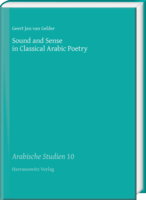|
|
more titles of the subject:
Download:
Please note: With adding digital Products to your cart
the payment will be handled via PayPal. The download will be provided after the payment is confirmed. An early 10th-century Arabic critic defined poetry formally as “metrical, rhymed, meaningful speech”. There are numerous studies of classical Arabic poetry, both pre-modern and modern, that deal with the themes and motifs of poems. Many of these pay scant attention to the formal aspects that distinguish Arabic poetry from prose: metre, rhyme, and other sound patterns. Likewise, there are many treatises and monographs on these formal aspects, but often they are more concerned with theory than with actual poetic practice, and they are rarely interested in the relationships between sounds and meanings.
Geert Jan van Gelder investigates these relationships in some detail, being concerned primarily with poetic practice rather than with the classical treatises on metre and rhyme. The introduction discusses what we know about the sounds of Classical Arabic verse, as far as we can tell from written sources. The chapters on metre and rhyme deal with the choices poets make and the consequences of the prosodical restraints. Relatively much attention is given to the oddities and freaks of versification. Another chapter illustrates the various sound patterns devised by poets to shape the verse. Sound and sense often clearly or subtly interact, although it is not claimed that they are always closely related. All Arabic examples and quotations are given in transliteration and are accompanied by translations; furthermore, introductions to Arabic prosody and phonology are provided in appendices. |
|||||||||||||||||||||||||||||||||||||||||






